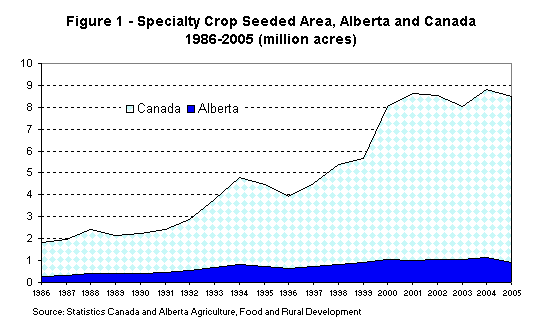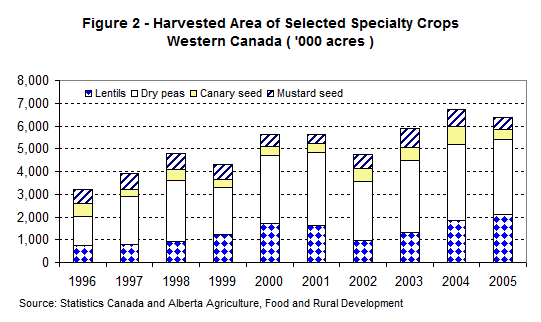| |
ndinformation needs of the specichmark statistics for some of the "new" and emerging crops.
Purpose of Survey
To address some of the data and information needs of the specialty crop industry in Alberta, the Statistics and Data Development (SADD) Branch conducts an annual Specialty Crop Survey. Now into its twenty-third year, the survey captures data on area, yield and production for specialty crops grown in the province.
Data gathered from the survey are used primarily to generate related provincial and sub-provincial estimates. In turn, these estimates are used to validate some of the Alberta estimates generated by Statistics Canada, as well as to provide industry and other stakeholders with benchmark statistics for some of the “new” and emerging crops.
Methodology
The Alberta Specialty Crop Survey, which is provincial in scope, collects data through a non-probability sampling procedure. In December 2005, survey questionnaires were mailed out to 3,315 specialty crop producers across the province. The questionnaires specifically asked survey participants to provide information on the type of specialty crop grown, area (seeded and harvested acres), yield and production for the year 2005. Survey participants were informed that participation in the survey was voluntary. Moreover, all individual responses would be kept confidential under the provisions of the Federal Statistics Act, as well as under the Provincial Freedom of Information and Protection of Privacy (FOIP) Act, by which the SADD Unit is governed and operates. As of March 23, 2005, a total of 814 questionnaires were returned. Of this total 716 were usable and partly formed the basis in the generation of the Alberta 2005 specialty crop estimates.
Survey responses received were reviewed for data completeness, validated and entered into an electronic database. The data was then subject to some computerized analyses, the results of which were rolled up into group summaries, to preserve data confidentiality of individual survey respondents. In turn, the group summaries, in conjunction with consultations with industry, published sources (e.g. Statistics Canada) and Alberta Agriculture, Food and Rural Development (AAFRD) subject area/provincial specialists were used to generate the provincial and sub-provincial (Census Division) estimates, where appropriate.
It cannot be over emphasized that extensive consultation is done with AAFRD’s subject area/provincial specialists and industry, in the derivation of the provincial/sub-provincial estimates. Subject area/provincial specialists are acknowledged for their useful information and valuable insights on crop conditions and yields, particularly when attempting to firm up some of the sub-provincial estimates generated from the survey. Likewise, administrative data showing yield and crop area grown under private contracts also tend to add value to some of the estimates.
It should be noted that the derived estimates are subject to error. Some of the possible causes of error include data coding, data entry and tabulation. Nonetheless, we believe that the statistics published in this report are reliable estimates for Alberta.
Survey Results
Area, yield and production in Alberta
Alberta producers planted fewer acres of specialty crops in 2005. Total provincial seeded area, excluding potatoes and forage seeds, was estimated at 0.90 million acres (see Figure 1), down 20 per cent from 1.13 million acres in 2004. The reduction in acreage can largely be attributed to fewer acres in dry peas and mustard seed. Of the total seeded area in 2005, nearly 0.81 million acres or 89 per cent were harvested for grains. To offer some perspective, shown in Figure 3 (see page 5) is the per centage distribution of specialty crop seeded acreage by crop type in 2005.
In general, growing conditions were favorable during the 2005 crop season, resulting in above average yields for most specialty crops grown on dryland. However, poor weather conditions in the fall significantly reduced crop quality.
In 2005, dry peas produced an average yield of 42.8 bushels per acre, or about nine per cent higher than in 2004, and about 19 per cent above the 10-year average. The provincial average yield of mustard seeds was estimated at 915 pounds per acre, slightly higher than the 2004 yield of 902 pounds per acre, and 23 per cent above the 10-year average. For chickpeas, the provincial average yield was a record 1,442 pounds per acre and up 14 per cent from 2004. It should be noted that due to cool, damp conditions, there were disease problems with dry beans, impacting yields in 2005. The provincial average yield for dry beans was estimated at 2,020 pounds per acre, in line with 2004, but down five per cent from the 10-year average.

Specialty crops in Western Canada
Based on the Statistics Canada November Estimate of Production of Principal Field Crops, 2005, and results of the Alberta 2005 Specialty Crop Survey, total seeded area of specialty crops in Western Canada dropped significantly from 2004. Total harvested area also decreased, but to a lesser extent, due to fewer abandoned acres. With reduced harvested area and lower yields for some specialty crops, total production was down in 2005, when compared to a year earlier.
In 2005, total seeded area of specialty crops declined for all of the provinces in Western Canada, when compared to 2004. For Western Canada, total seeded area in 2005 was estimated at 7.88 million acres, with Saskatchewan accounting for 77 per cent of the total or 6.06 million acres. About 12 per cent of the total seeded area was in Alberta, while 11 per cent was in Manitoba. Only a small acreage of specialty crops was planted in British Columbia. The total harvested area in Western Canada in 2005 was 7.40 million acres, or about two per cent lower than the 7.54 million acres in 2004.
The four major specialty crops grown in Western Canada in 2005 were dry peas, lentils, canary seed and mustard seed, and accounted for 83 per cent of the total seeded area. More specifically, dry peas remained the largest specialty crop in Western Canada, with a total seeded area of 3.38 million acres. It also represented 43 per cent of the total seeded area of specialty crops in Western Canada. Lentils was next, with seeded acres totaling 2.18 million or 28 per cent of the Western Canada total, while mustard seed and canary seed represented seven per cent and six per cent, respectively.
The total harvested area of the four major specialty crops in Western Canada is shown in Figure 2. Statistics on seeded area and production of selected specialty crops are presented in Table 5 (see page 16).

Acknowledgments
The Statistics and Data Development Branch of Alberta Agriculture and Rural Development (ARD) wishes to thank all of the producers who participated in the Alberta 2005 Specialty Crop Survey conducted in the winter of 2005/2006. Without their cooperation and assistance, this report would not have been possible.
Many ARD staff members have made significant contributions to the successful completion of this report. Those staff include Chuanliang Su of Statistics and Data Development Unit, Charlie Pearson of Market and Consumer Analysis Unit, Nabi Chaudhary of Economics Unit, and Manjula Bandara, Forrest Scharf, Judy Webber, Shauna Pow, Judy Tokuda, Valerie Catinot, Julie Lecombe, Kwesi Ampong-Nyarko, John Brown, Jill De Mulder, Zhixiong Zhang, and April Jiao of Agriculture Research Division.
Maureen Wenger of M. C. Wenger Consulting was contracted to help conduct the Alberta 2005 Specialty Crop Survey. Additionally, several staff members of the Statistics and Data Development Branch, including Grant Sorenson, Gail Atkinson, Guangzhi Liu, Marion Harry, and Marian Elson, have provided valuable assistance to the report. Our thanks go to all these individuals and others who have contributed to the report.
Contacts
For additional information relating to the various sections of this report, please do not hesitate to contact the subject area specialist referenced under each section.
| For the complete survey report download .pdf file attached on top of page. |
|
|